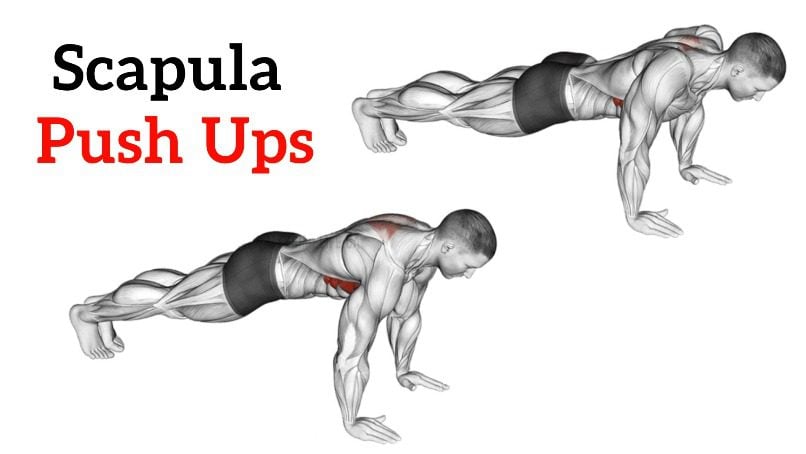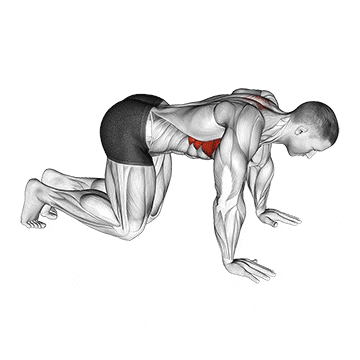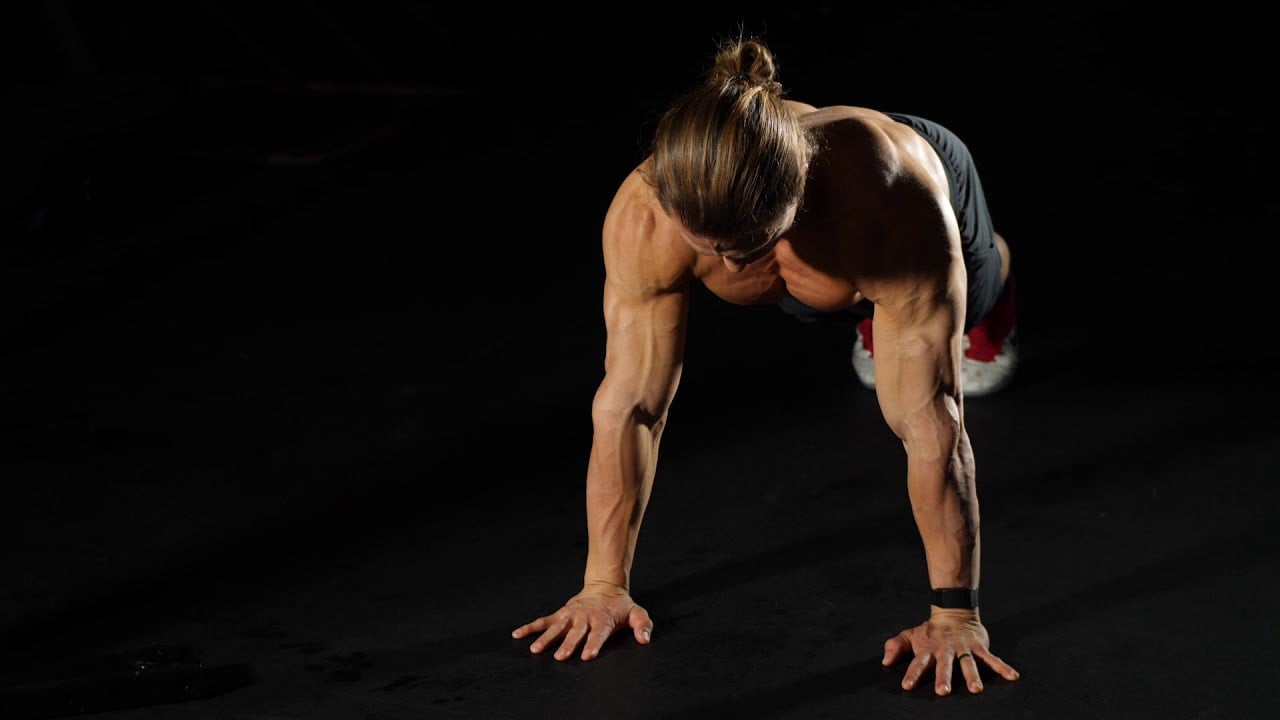Scapula push-ups (scapula retraction push-ups or scap push ups) are highly effective exercises often used in shoulder warm-ups and rehabilitation routines.
If you have shoulder pain or are recovering from an injury, they can help you. They are among the best exercises for strengthening the upper back muscles and improving shoulder strength and mobility.
It uses a small range of motion to strengthen your scapular muscles.
As poor scapula mechanics are often the root cause of shoulder injuries. In addition to shoulder issues, they can lead to poor posture, neck and back pain, and limited mobility.
The scapula, also known as the shoulder blade, is a large triangular-shaped bone in the upper back. A complex system of muscles works together to help you move your arm and shoulder.
The scap push-up promotes natural scapula motion, improves posture and shoulder mobility, and improves form during upper body exercises.
Want to take your gains to the next level? Discover your daily calorie needs with our free TDEE calculator

Scapula Push-Up Muscles Worked
- Primary Muscles: Serratus anterior, Trapezius (middle trap and lower trap)
- Secondary Muscles: Rhomboids and Pectoralis Minor
- Stabilizing Muscles: Rotator Cuff (Supraspinatus, Infraspinatus, Teres Minor, Subscapularis), Core Muscles (Abdominals, Obliques), Quadratus lumborum and Triceps
How To Do Scapula Push Up
- You should get in the standard push-up position, with your hands under your shoulders, arms straight, and body in a straight line from head to heels.
- Keep your spine neutral, tuck your chin slightly, and brace your abs to prevent your lower back from sagging.
- Let your chest drop towards the ground without bending your elbows. This movement comes from retracting your shoulder blades—pulling them back and squeezing them together.
- Keep your neck in line with your spine, and don’t let it shoot forward, or your hips sag. Focus on controlled movement from your shoulder blades.
- Keep your arms straight and retract your shoulder blades by pulling them back and together and squeezing them at the top of the movement.
- After retracting, push your shoulder blades apart as far as possible without bending your elbows. Pause here for a moment to engage your serratus anterior.
- Continue with the controlled movement for the recommended sets and reps. This isn’t a race—it’s about building strong, stable shoulders.
Proper Form And Tips
- Keep your abs tight to prevent your lower back from arching and to maintain proper spinal alignment.
- Tuck your chin slightly to avoid neck strain and keep it aligned with your spine.
- Avoid bending your elbows during the movement—this is about scapular movement, not pushing with your arms. Do a small range of motion.
- Focus on slow, controlled scapular retraction and protraction. This maximizes the activation of your serratus anterior and promotes proper shoulder mechanics.
- Incorporate proper warm-ups, rest, and nutrition into your exercise program to see continual progress and build body strength.
- If you’re a beginner, perform the exercise from your knees or against a wall to reduce load.
Benefits Of Scapula Push-Ups
The scap push-ups are a good choice for training. The benefits of regularly performing them include:
- The scapula muscle powers the shoulder and shoulder blades. Working out this muscle group helps keep your shoulders strong and healthy.
- The scapular pushup calls on strength in the serratus anterior, helping keep your shoulders working with power and full range of motion.
- The benefit of using scap pushups is that they help develop core strength, since you can perform them in the plank position. The scap push-up is also a great move to help improve your posture.
- They can help you improve your balance, coordination, stability, and flexibility. They are an excellent choice if you want to get better at any sport or form of exercise.
- The Scapular Push-Up is an excellent exercise for building stabilizing strength and mobility in your shoulder blades. This improves the effectiveness of the golf swing and prevents injuries.
- You don’t need any special equipment to practice the scap push-ups workout. All you require is the right technique and some willpower.
Make It Easier Or Harder (Regression & Progression)
Want to adjust the difficulty of scap push-ups? No problem.
- An easier version is to do them against a wall or on your knees. This is beginner-friendly because it requires less load and flexibility.
- To increase the difficulty, add more sets or elevate your feet slightly. However, avoid taking scap push-ups to failure or adding heavy resistance. Focus on controlled movement instead.
1. Wall Scap Push Up
Push-ups on the wall are a low-impact exercise that people of all fitness levels can perform. So, they are a good choice for people who are just starting to do strength training.
It is a beginner-friendly exercise for building stabilizing strength and mobility in your shoulder blades. Try the wall scapular push-up exercise to develop muscle control and mobility.
2. Knee Scapula Push Up
Bent Knee push-ups are one of the most basic and rewarding exercises you can do. It’s always beneficial to do them regularly.
It is perfect for beginners or those with limited upper body strength. They help build a foundation for scapular mobility and stability without the added challenge of a full plank position.
With less weight to manage, you can focus more on the precise movement of scapular retraction and protraction.

3. Elbow Scapula Push Up (Plank Scap Push Up)
Unlike standard scapula push-ups, the elbow variation reduces pressure on your wrists, making it a great alternative for those with wrist discomfort or limitations.
The plank is a brilliant bodyweight exercise that helps you develop your core’s strength and stability.
The elbow scapula push up is a beneficial strengthening exercise that targets scapular stability through the retraction, anterior tilt, and protraction positions.
Perform the slight movement of your shoulder blades (Protraction and retraction) to feel your upper back and keep your Abs braced.
References
- Suprak DN, Bohannon J, Morales G, Stroschein J, San Juan JG. Scapular Kinematics and Shoulder Elevation in a Traditional Push-Up. J Athl Train. 2013 Nov-Dec;48(6):826-835. doi: 10.4085/1062-6050-48.5.08. PMCID: PMC3867095. PMID: 23952043.
- Lear LJ, Gross MT. An Electromyographical Analysis of the Scapular Stabilizing Synergists During a Push-Up Progression. J Orthop Sports Phys Ther. 1998;28(3):146-157. doi: 10.2519/jospt.1998.28.3.146.
- Contemori S, Panichi R, Biscarini A. Effects of scapular retraction/protraction position and scapular elevation on shoulder girdle muscle activity during glenohumeral abduction. Hum Mov Sci. 2019 Apr;64:55-66. doi: 10.1016/j.humov.2019.01.005.

Manish is a NASM-certified fitness and nutrition coach with over 10 years of experience in weight lifting and fat loss fitness coaching. He specializes in gym-based training and has a lot of knowledge about exercise, lifting technique, biomechanics, and more.
Through “Fit Life Regime,” he generously shares the insights he’s gained over a decade in the field. His goal is to equip others with the knowledge to start their own fitness journey.


